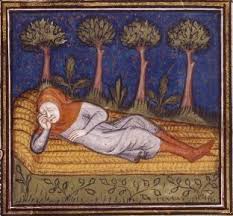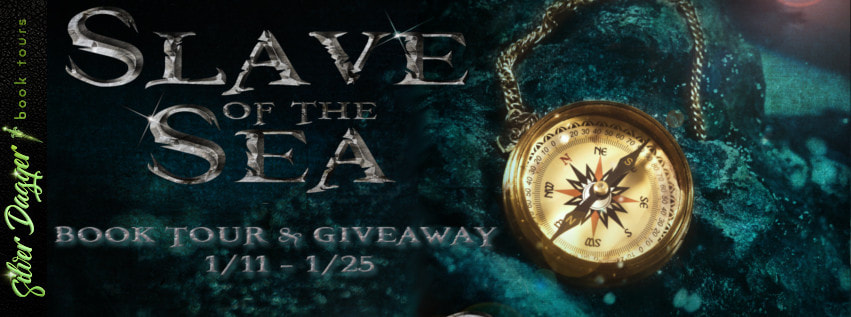Originally Posted by Allison D. Reid:
Medieval Monday: Sleep (part 1) talked about how sleep cycles in the Middle Ages differed from those of the present day. This post goes into other information related to sleep.
 What you wore, where you slept, and what you slept on were all related to your social status. The average person in the Middle Ages didn’t have a separate sleeping area. In a one room cottage, everyone slept crammed in together on thin woven mats, or mattresses stuffed with wool, hay or moss. Fleas, lice, and other pests were frequent, unwelcome guests that plagued commoners and kings alike. They were sometimes combated with ticking (tightly woven mattress covers), herbs that were known to be insect-repellents, or by storing bedding in cedar chests. While the wealthy had the advantage of feather beds and pillows, and fur coverlets, pest were attracted to them. Bed filling was usually only changed once each year.
What you wore, where you slept, and what you slept on were all related to your social status. The average person in the Middle Ages didn’t have a separate sleeping area. In a one room cottage, everyone slept crammed in together on thin woven mats, or mattresses stuffed with wool, hay or moss. Fleas, lice, and other pests were frequent, unwelcome guests that plagued commoners and kings alike. They were sometimes combated with ticking (tightly woven mattress covers), herbs that were known to be insect-repellents, or by storing bedding in cedar chests. While the wealthy had the advantage of feather beds and pillows, and fur coverlets, pest were attracted to them. Bed filling was usually only changed once each year.
A fireplace was the only source of heat and would have to be tended in the middle of the night to keep it going. In a peasant home, the fireplace was little more than an open hearth in the center of the room (sometimes with a hole in the ceiling above it for ventilation). Once the shutters and doors were all closed for the night, the room would be quite smoky. Heavy rains might drip through the thatch roof overhead, or drive insects and mice indoors, and wind whistled noisily through the walls and windows. A somewhat larger peasant home might have two rooms—one for the people, another for the animals—or a sleeping loft above.
 If you had a bit more wealth, your sleeping arrangements would be more comfortable, but surprisingly not any more private. A real bed, with a mattress and drawn curtains was quite expensive and might be passed down through the family. Though the likelihood of having a separate sleeping room was greater, the whole family would sleep together in one bed, with servants sleeping nearby on straw mats. Guests of the household might also be invited to share the bed.
If you had a bit more wealth, your sleeping arrangements would be more comfortable, but surprisingly not any more private. A real bed, with a mattress and drawn curtains was quite expensive and might be passed down through the family. Though the likelihood of having a separate sleeping room was greater, the whole family would sleep together in one bed, with servants sleeping nearby on straw mats. Guests of the household might also be invited to share the bed.
Other types of beds could be quite small, designed for only one person. They might have a sloped back and knee support, more like sleeping in a reclining chair than a bed. It was always advantageous to have space between the floor and the bed so that cold didn’t seep up from the floor. Women tended to braid or tie up their hair at bedtime, and it was common for everyone to sleep with a head covering for added warmth. If it was particularly cold, hot stones or a bed warmer (filled with hot coals from the fire) might be placed beneath the blankets until the bed was warm, or the blankets might simply be turned all the way down to allow in heat from the hearth.
 It is generally thought that most medieval people slept without clothes, but period artwork shows a variety of nightly attire. Some slept nude while others wore simple gowns and shirts, or even just their daily underclothes. Monks were known to sleep in their robes for warmth since they always slept alone. By the late Middle Ages nightshirts and nightgowns were common. What was worn depended on one’s means, personal preferences, time of year, and sleeping conditions, and who else was sharing the bed.
It is generally thought that most medieval people slept without clothes, but period artwork shows a variety of nightly attire. Some slept nude while others wore simple gowns and shirts, or even just their daily underclothes. Monks were known to sleep in their robes for warmth since they always slept alone. By the late Middle Ages nightshirts and nightgowns were common. What was worn depended on one’s means, personal preferences, time of year, and sleeping conditions, and who else was sharing the bed.
One thing both wealthy and poor had in common–neither much enjoyed going outside to the bathroom in the middle of the night, so chamber pots were used. Urine collected in these pots had a variety of uses, from cleaning, to sterilizing wounds and tools, to processes like fulling wool. Over the chamber pot there might be a chair with a hole in the seat and a cover to help contain the smell.
Want to learn more about what daily life was like in the Middle Ages? You can find all of my previous posts in the Medieval Monday Index.


No comments:
Post a Comment